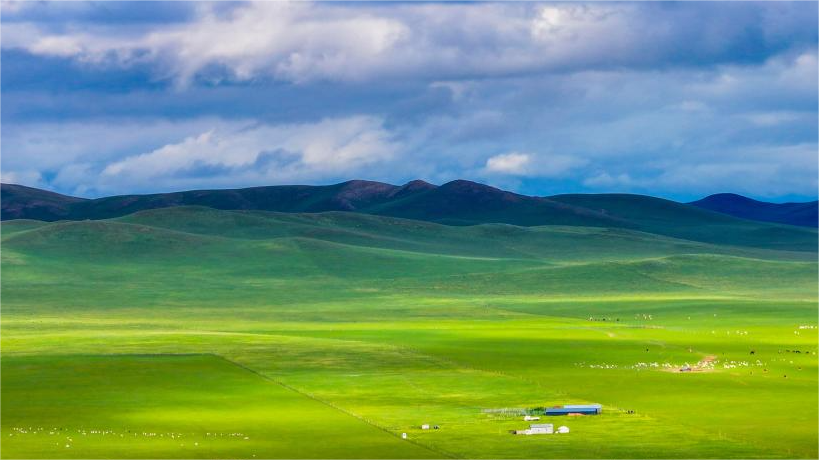County in SW China's Guizhou addresses rock desertification, develops green industries
Guanling Buyi and Miao Autonomous County in southwest China's Guizhou Province has significantly reduced the area of rock desertification through persistent efforts and developed green industries.

Photo shows the hybrid giant napier grass on a mountain in Jinlong village, Xinpu township, Guanling Buyi and Miao Autonomous County, southwest China's Guizhou Province. (Photo courtesy of the publicity department of the Communist Party of China Guanling county committee)
Zuo Luolian is a 36-year-old monitor at a monitoring station for water and soil conservation in Guanling. The monitoring station has set up six experimental plots with different vegetation to study soil erosion. It collects samples and uploads relevant data after testing and analysis to a provincial-level database for more targeted rock desertification control.
The Guizhou Provincial Water Resources Department established the Guanling monitoring station. Li Guangming, an official in Guanling, explained that the station is being used to compare the effectiveness of various types of vegetation in conserving water and soil. It has allowed for the building of a database that gives research institutes both inside and outside the province the ability to collaborate. This collaboration makes rock desertification control more science-based.
Zuo has observed that the data accumulated over the past years shows that grasslands are most effective at water and soil conservation, followed by tall trees and fruit trees. He added that the data is used not only for rock desertification control but also to develop related ecological industries.
"Since 2019, our focus has shifted from quantity to precision in rock desertification control. We have explored a path of more targeted treatment that considers both local conditions and the development of industries," Li said.
Since 2005, Guizhou has used satellite remote sensing technology for monitoring and conducting rock desertification surveys every five years. Starting in 2024, Guizhou will change to annual updates on rock desertification data. This will include lists of grass and tree species that have both positive and negative effects to allow for more precise guidance on rock desertification control.
Guanling is one of the regions most severely affected by rock desertification in Guizhou. In the county, 42.5 percent of the land was once plagued by rock desertification.
The county first adopted a model that combined the goals of afforestation and conserving water and soil to combat rock desertification, said Zhao Shouping, deputy director of the water resources bureau of the county.
Zhao explained that cypress trees were planted on slopes and ditches were built on steeper slopes. The county managed to increase the survival rate of cypress trees from 30 percent in the first year of planting to over 85 percent in the seventh year, said Pan Wencheng, head of the forestry bureau in Guanlian county.
From 2015 to 2022, the rock desertification area in Guanling decreased by 412 square kilometers, or 61.86 percent. The forest coverage rate in the county has increased from 45.42 percent in 2015 to 59.12 percent now. The county has been designated as a demonstration zone for the comprehensive treatment of rock desertification in Guizhou.
In 2018, Wang Zeping hailing from Yichang city in central China's Hubei Province came to Xinpu township in Guanling to grow citrus trees and other fruit trees on the rocky mountains.
In early 2023, Wang's trees bore fruits, and the yield reached 75,000 kilograms. This year, Wang expects the yield to double, with the output value potentially exceeding 10 million yuan ($1.37 million).
Yang Zhiwei, a villager in Longtan village in Guanling, has grown loquat trees on the rocky mountains. Yang earns over 50,000 yuan annually from loquat cultivation alone. He has also actively participated in several rock desertification control projects in the county.
Guanling has promoted the cultivation of the hybrid giant napier grass, a high-yielding grass variety that is effective in controlling rock desertification and ensures a stable food supply to Guanling cattle, a fine yellow cattle breed in Guizhou. The county has explored a development model of green industries including the farming of Guanling cattle and the planting of napier grass.
Currently, Guanling has grown forage grass on 155,500 mu (10,366.7 hectares) of land, with the output value per mu reaching 3,000 yuan. Additionally, 100,000 mu of barren hills and slopes have been improved through grass planting.
Photos
Related Stories
- China forges ahead at forefront of global battle against desertification
- Chinese wisdom in battle against desertification
- S China's Guangxi addresses rocky desertification, brings prosperity to locals
- NW China makes efforts to combat desertification
- China, Mongolia open joint center to curb desertification
- Chinese official urges deepening international cooperation to fight desertification
- Tree planting controls rocky desertification in SW China
- Interview: China's anti-desertification experience conducive to global green development, UN official says
- Int'l students experience China's anti-desertification work
- China builds strong ecological barrier with science-based desertification control
Copyright © 2024 People's Daily Online. All Rights Reserved.









